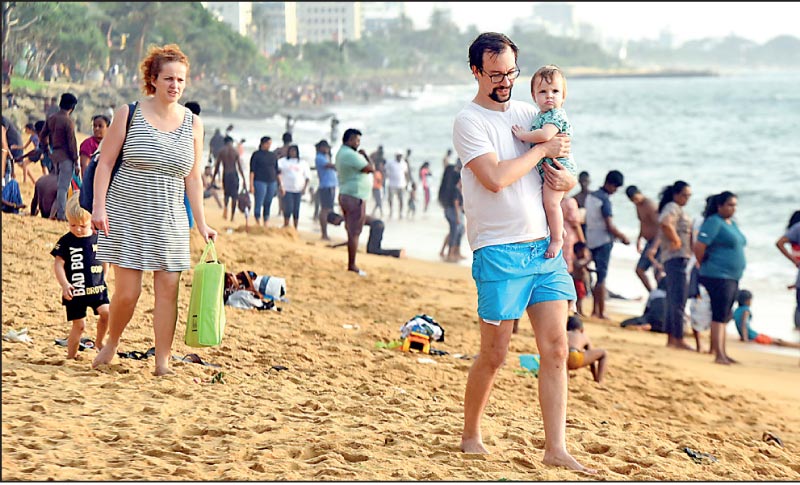Monday Apr 28, 2025
Monday Apr 28, 2025
Monday, 1 January 2024 05:06 - - {{hitsCtrl.values.hits}}

A foreign family on holiday enjoying time at Wellawatte beach last week – Pic by Pradeep Pathirana
By Charumini de Silva
|
Tourism Minister Harin Fernando
|
Sri Lanka’s tourism industry has achieved a robust revival in 2023, marking a significant milestone by registering the highest influx of visitors to Sri Lanka since 2019.
With almost 1.5 million visitors, the country has made significant strides amid consecutive challenges during the past four years.
This resurgence in visitor numbers reflects a positive trajectory for Sri Lanka’s tourism industry, showcasing its resilience and recovery after facing various challenges, including the impact of the 2019 Easter Sunday tragedy and the subsequent disruptions caused by the COVID-19 pandemic and adverse travel advisories imposed by numerous countries particularly in 2022 amid political and economic crisis.
“The recovery of the tourism industry is a testament to the collective efforts of the Government and private sector champions. The upward trajectory in tourist arrivals and earnings signifies a promising future for the industry and its integral role in the country’s economic growth. I think the total arrivals for 2023 will be almost 1.5 million, which was the original target set or slightly below that,” Tourism Minister Harin Fernando told the Daily FT.
He also said that the tourist arrivals surpassed 200,000 as of 30 December, marking the highest number of visitors received in a month over the past three years.
“It is a great leap ahead from the 2022 crisis year,” he added.
From 1-28 December, Sri Lanka welcomed a total of 189,605 tourists, pushing the cumulative figure for the year to over 1.46 million, a significant rebound from the challenges faced in 2022. The strong start to December has set a positive tone for reaching the ambitious goal of 242,135 arrivals, achieving over 80% of the monthly target.
Fernando sees this achievement as a testament to the country’s enduring appeal as a premier travel destination, highlighting Sri Lanka’s vast potential in furthering the tourism industry.
The daily average of tourist arrivals increased steadily between November and December, with the daily average in December surging to 6,772 from 5,049 in the previous month. The resumption of charter flights, regular cruise liners as well as the visa-free scheme has played a pivotal role in boosting arrivals in December.
India emerged as the single biggest source market in 2023 with over 300,000 tourists, whilst Europe was the largest region that contributed to the annual tourist inflow to Sri Lanka with Russia taking the lead of over 200,000 tourists, followed by the UK with over 130,000 tourists and Germany with over 101,000 tourists.
Originally, the Sri Lanka Tourism Development Authority (SLTDA) projected to attract 1.55 million tourists and $ 3 million in earnings, but the target was revised upwards to 2 million amid a surge in arrivals in July. However, the figures were later adjusted back to the initial target of 1.55 million, along with the dip in earnings expectations to $ 2.7 billion.
During the first 11 months of 2023, tourism earnings registered a 78.3% year-on-year (YoY) increase reaching $ 1.79 billion, the latest data from the Central Bank data showed. In November tourism earnings accounted for $ 205.3 million, slightly below the $ 219 million generated in July, the highest monthly income achieved in 2023 thus far.
Minister Fernando revealed the tourism sector’s ambitious target for 2024, aiming to welcome 2.5 million tourists and generate over $ 3.5 billion in revenue, whilst setting its sights on increasing arrivals to 5 million and earning an impressive $ 21.6 billion within six years.
As part of its long-term strategy to welcome 5 million visitors by 2030, it hopes to lift the average spending per visitor to $ 4,000, with 2.5 million of them spending over $ 500 per day, indicating a concentration on luring high-end tourists.
Sri Lanka’s tourism, which recorded its highest growth of 46.1% in 2010 after the end of a 30-year conflict, faced downward trends in subsequent years. However, the positive growth of 26.7% in 2013 marked a turning point after a decade-long descending trend. The industry now looks ahead with optimism, fuelled by the recent success and ambitious targets set for the coming year.
Discover Kapruka, the leading online shopping platform in Sri Lanka, where you can conveniently send Gifts and Flowers to your loved ones for any event including Valentine ’s Day. Explore a wide range of popular Shopping Categories on Kapruka, including Toys, Groceries, Electronics, Birthday Cakes, Fruits, Chocolates, Flower Bouquets, Clothing, Watches, Lingerie, Gift Sets and Jewellery. Also if you’re interested in selling with Kapruka, Partner Central by Kapruka is the best solution to start with. Moreover, through Kapruka Global Shop, you can also enjoy the convenience of purchasing products from renowned platforms like Amazon and eBay and have them delivered to Sri Lanka.
Discover Kapruka, the leading online shopping platform in Sri Lanka, where you can conveniently send Gifts and Flowers to your loved ones for any event including Valentine ’s Day. Explore a wide range of popular Shopping Categories on Kapruka, including Toys, Groceries, Electronics, Birthday Cakes, Fruits, Chocolates, Flower Bouquets, Clothing, Watches, Lingerie, Gift Sets and Jewellery. Also if you’re interested in selling with Kapruka, Partner Central by Kapruka is the best solution to start with. Moreover, through Kapruka Global Shop, you can also enjoy the convenience of purchasing products from renowned platforms like Amazon and eBay and have them delivered to Sri Lanka.